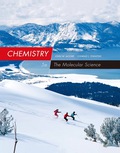
(a)
Interpretation:
Activation energy and frequency factor for the given reaction has to be calculated.
Concept Introduction:
The temperature dependence of rate constant can be explained through Arrhenius equation.
Where
The logarithmic form of Arrhenius is given below.
Where,
(a)
Answer to Problem 52QRT
The activation energy is calculated as
Explanation of Solution
The activation energy can be calculated using following formula,
Given,
On substituting these values in the above equation gives the activation energy as shown below.
The activation energy is calculated as
Frequency factor can be calculated using the two given temperature.
Frequency factor calculated using
Frequency factor calculated using
Therefore the average value of frequency factor is
(b)
Interpretation:
Rate constant of the reaction at a temperature of
Concept Introduction:
Refer to part (a).
(b)
Answer to Problem 52QRT
The value of the rate constant is calculated as
Explanation of Solution
Rate constant can be calculated using Arrhenius equation.
Given,
Substituting these values gives the value of rate constant as follows,
The value of the rate constant is calculated as
Want to see more full solutions like this?
Chapter 11 Solutions
EBK CHEMISTRY: THE MOLECULAR SCIENCE
- Three first-order reactions have the following activation energies: (a) Which reaction is the fastest? (b) Which reaction has the largest half-life? (c) Which reaction has the largest rate?arrow_forwardWhen phenacyl bromide and pyridine are both dissolved in methanol, they react to form phenacylpyridinium bromide. When equal concentrations of reactants were mixed in methanol at 35 C, these data were obtained: (a) Determine the rate law for this reaction. (b) Determine the overall order of this reaction. (c) Determine the rate constant for this reaction. (d) Determine the rate constant for this reaction when the concentration of each reactant is 0.030 mol/L.arrow_forwardWhen enzymes are present at very low concentration, their effect on reaction rate can be described by first-order kinetics. Calculate by what factor the rate of an enzyme-catalyzed reaction changes when the enzyme concentration is changed from 1.5 107 M to 4.5 106 M.arrow_forward
 Chemistry: The Molecular ScienceChemistryISBN:9781285199047Author:John W. Moore, Conrad L. StanitskiPublisher:Cengage Learning
Chemistry: The Molecular ScienceChemistryISBN:9781285199047Author:John W. Moore, Conrad L. StanitskiPublisher:Cengage Learning Principles of Modern ChemistryChemistryISBN:9781305079113Author:David W. Oxtoby, H. Pat Gillis, Laurie J. ButlerPublisher:Cengage Learning
Principles of Modern ChemistryChemistryISBN:9781305079113Author:David W. Oxtoby, H. Pat Gillis, Laurie J. ButlerPublisher:Cengage Learning Chemistry: Principles and ReactionsChemistryISBN:9781305079373Author:William L. Masterton, Cecile N. HurleyPublisher:Cengage Learning
Chemistry: Principles and ReactionsChemistryISBN:9781305079373Author:William L. Masterton, Cecile N. HurleyPublisher:Cengage Learning Chemistry: Principles and PracticeChemistryISBN:9780534420123Author:Daniel L. Reger, Scott R. Goode, David W. Ball, Edward MercerPublisher:Cengage Learning
Chemistry: Principles and PracticeChemistryISBN:9780534420123Author:Daniel L. Reger, Scott R. Goode, David W. Ball, Edward MercerPublisher:Cengage Learning Chemistry by OpenStax (2015-05-04)ChemistryISBN:9781938168390Author:Klaus Theopold, Richard H Langley, Paul Flowers, William R. Robinson, Mark BlaserPublisher:OpenStax
Chemistry by OpenStax (2015-05-04)ChemistryISBN:9781938168390Author:Klaus Theopold, Richard H Langley, Paul Flowers, William R. Robinson, Mark BlaserPublisher:OpenStax





